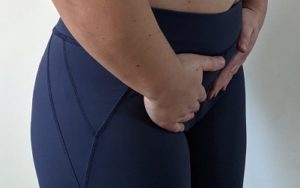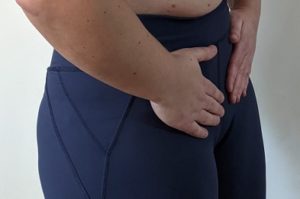How your pelvis ‘sits’ within your body can have a huge impact on the capacity to:
- Move well.
- Transfer forces through the spine.
- Support the internal and pelvic organs.
- Breathe well.
- Maintain the tone of all the muscles (that’s 72 in total) , amongst many other factors.
I think of the Pelvis as being like the Spaghetti Junction of the body. It’s in the middle and everything travels through it. All muscles are at their strongest/most supportive when they are at their optimum position. Given how many muscles attach and have an influence on the pelvis, we can start to see how a change in one area can start to have an impact on other areas.
Therefore, pelvic alignment important for everyone but it can be a particularly important area to address if you are experiencing back pain, pelvic organ prolapse, urinary leakage, diastasis recti or any other symptoms that make you think twice or stop you from doing the things you love.
Where do you put your pelvis?
To help you find the positioning of your pelvis, I want you to identify if you ‘tip’ or ‘tuck’.
- Place the heels of your hands on the hip bones (anterior superior iliac spine – ASIS) and your fingertips on the Pubis Symphasis (PS).
- Does it feel like the PS is behind the ASIS (tipping – anterior tilt).
- Or, does it feel like the PS is in front of the ASIS (tucking – posterior tilt) – I don’t do this very well. It’s not my pattern.
- Tip your pelvis forwards and backwards (you may need to soften your knees to achieve this). You should feel the PS move backwards and forwards in relation to the ASIS. Pause when you feel like the ASIS and the PS are level with each other. This is neutral and the positioning we are aiming for on a more consistent unconscious basis. Does feel easy or hard for you to be in that position? Does it feel comfortable or alien to your body?
What do these positions mean for our bodies?
If you found you were tucking your pelvis under …
When the pelvis tucks under (known as a Posterior Tilt) the pelvis is drawn backwards and downwards. This position can increase the tension in the muscles at the back of your legs and pelvic floor. When in this position over a prolonged time, the buttocks may develop a flattened look as it is more difficult to engage them effectively from this position. Not great for Pelvic Organ Prolapse or incontinence symptoms.
If you found that you were tipping your pelvis forward ….
When the pelvis tips forward (known as an Anterior Tilt) the pelvis is drawn forwards and down. The position can increase the tension in the muscles at the front of the hips and legs. This pulls on the abdominal muscles that attach to the top of the pelvis making it harder for them to engage, manage intra-abdominal pressure and support the spine. Not great for a Diastasis Recti.
How to achieve a more beneficially consistent position for your Pelvis?
Bringing greater awareness is the first step important when it comes to maintaining the integrity of our core. Now that you are aware of the position your Pelvis prefers to rest in you can introduce more of the opposite into your day. Notice if you have gone into a tipping or tucking pelvis position when you’re stood talking to a friend or waiting in a queue, or sat a work and ‘re-find’ neutral.
Introducing mobility and strengthening exercises can be used to bring balance back to the muscles and the best thing is that once our bodies know how to achieve them we can incorporate them into our daily exercise, which help continue to support the body.
If you want to find out more about how you can address the subject of this blog just get in touch. Let me know what’s going on for you and we can have a chat about how I can help.




Recent Comments